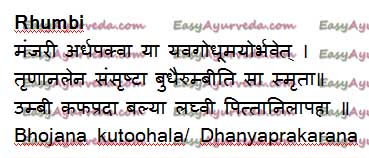Traditional Corn Snack – Rumbi Qualities And Health Benefits
This article is by Dr M S Krishnamurthty MD (Ayu),PhD.
Corn snacks are highly appreciated for nutritive value, taste and fun of masala magic that happens in our mouths!
Today we find the baby corn, sweet corn, American sweet corn, wheat corns, baked or half baked with spices, salt, butter etc. in various chat centers.
In fact few of them are healthy too. But hygiene aspect should be considered in outdoor corn corners.
In classical text Bhojana kutoohala it is explained by the name ‘Rumbi’ or ‘Umbi’.
Classical Reference: Bhojana kutoohala/ Dhanya prakarana
This is called Bombi in Hindi.
Table of Contents
Classical reference

Read related – Jalebi – Ayurvedic Method, Qualities, Health Benefits
Preparation method
Half matured or fully matured (but not dried) barley or wheat seed cluster (corn bunch) is taken and half cooked or baked directly keeping over the charcoal or by using the paddy husk or firewood till it is soft and slightly brown in color. According to ones need rock salt, pepper, lemon, lemon mixed chilly powder etc can be added or applied.
This should be eaten when it is warm.
Once it gets cold, it becomes hard to chew and more importantly hard to digest.
Today Chat masala, ghee etc are also added.
Read related: Wheat – Barley Chapati And Roti: Health Benefits
Qualities
Increase kapha, energizer, light to digest and decrease pitta and vata.
Read related – Ayurvedic Wheat Flour Ladoo With Jaggery: Preparation, Benefits
Wider utility
A variant of that is half boiled wheat, barley or chickpeas. In classical texts it is called Kulmasha. Quality wise it is different from the fried and baked corns. In Hindi it is called Gugarya. It is heavy, dry, aggravate vata and laxative in nature.
Read related: Wheat Uses, Health Benefits, Side Effects
Ancient classical snacks are still in practice. But changes can be observed in additives as well as in baking ways. So a thorough review regarding such food practices in ancient texts will add more to present day texts and practices of dietetics.
Corn, sweet, yellow, cooked, boiled, drained, with salt
Taste – astringent, sweet, slightly salty
Properties – dry, light
Potency – not very cold (as salt is hot in potency)
After digestion taste transformation ( Vipaka ) – Pungent
Effect on Doshas
Vata increasing
Pitta nourishing (salt is Pittakara)
Kapha balancing (more Kapha balancing when compared to raw corn as it is lighter due to heat processing)
Corn, sweet, yellow, canned, no salt added, solids and liquids
(Includes foods for USDA’s Food Distribution Program)
Taste
– sweet
Properties – dry, light
Potency – cold
After digestion taste transformation ( Vipaka ) – Sweet
Effect on Doshas
Vata increasing
Pitta balancing
Kapha balancing
Corn, sweet, yellow, canned, cream style, no salt added
Taste – astringent, sweet
Properties – not very dry, not very light
Potency – cold
After digestion taste transformation ( Vipaka ) – Pungent
Effect on Doshas
Vata increasing (does not increase Vata to a great extent as it is less dry and not very light)
Pitta balancing
Kapha balancing (more Kapha balancing when compared to raw corn as it is lighter due to heat processing)
Corn, sweet, yellow, canned, vacuum pack, no salt added
Taste – astringent, sweet
Properties – dry, light
Potency – cold
After digestion taste transformation ( Vipaka ) – Pungent
Effect on Doshas
Vata increasing
Pitta balancing
Kapha balancing (more Kapha balancing when compared to raw corn as it is lighter due to heat processing)
Corn, sweet, yellow, frozen, kernels, cut off cob, boiled, drained, with salt
Taste – astringent, sweet, slightly salty
Properties – dry, light
Potency – not very cold (salt is hot in potency)
After digestion taste transformation ( Vipaka ) – Pungent
Effect on Doshas
Vata increasing
Pitta nourishing (salt is Pittakara)
Kapha balancing (more Kapha balancing when compared to raw corn as it is lighter due to heat processing)
Corn, sweet, yellow, frozen, kernels on cob, cooked, boiled, drained, with salt
Taste – astringent, sweet, slightly salty
Properties – dry, light (as it is heat processed)
Potency – not very cold (salt is hot)
After digestion taste transformation ( Vipaka ) – Pungent
Effect on Doshas
Vata increasing
Pitta nourishing (salt is Pittakara)
Kapha balancing (it becomes light and Kapha balancing due to heat processing)
Corn, sweet, white, raw
The only difference between yellow and white corn is that the naturally occurring pigment that makes those kernels yellow, beta carotene, gives them a bit of a nutritional edge over white corn—beta carotene turns into vitamin A during digestion.
Taste – astringent, sweet
Properties – dry, light
Potency – cold
After digestion taste transformation ( Vipaka ) – Pungent
Effect on Doshas
Vata increasing
Pitta balancing
Kapha balancing
Corn, sweet, white, cooked, boiled, drained, without salt
Taste – astringent, sweet
Properties – dry, light
Potency – cold
After digestion taste transformation ( Vipaka ) – Pungent
Effect on Doshas
Vata increasing
Pitta balancing
Kapha balancing (more Kapha balancing when compared to raw corn as it is lighter due to heat processing)
Corn, sweet, white, cooked, boiled, drained, with salt
Taste – astringent, sweet, slightly salty
Properties – dry, light
Potency – not very cold (salt is hot in potency)
After digestion taste transformation ( Vipaka ) – Pungent
Effect on Doshas
Vata increasing
Pitta nourishing (salt is Pittakara)
Kapha balancing (more Kapha balancing when compared to raw corn as it is lighter due to heat processing)
Corn, sweet, white, canned, whole kernel, regular pack, solids and liquids
Taste – astringent, sweet
Properties – dry, light
Potency – cold
After digestion taste transformation ( Vipaka ) – Pungent
Effect on Doshas
Vata increasing
Pitta balancing
Kapha balancing (more Kapha balancing when compared to raw corn as it is lighter due to heat processing)
Corn, sweet, white, canned, whole kernel, no salt added, solids and liquids
Taste – astringent, sweet
Properties – dry, light
Potency – cold
After digestion taste transformation ( Vipaka ) – Pungent
Effect on Doshas
Vata increasing
Pitta balancing
Kapha balancing (more Kapha balancing when compared to raw corn as it is lighter due to heat processing)
Corn, sweet, white, canned, whole kernel, drained solids
Taste – astringent, sweet
Properties – dry, light
Potency – cold
After digestion taste transformation ( Vipaka ) – Pungent
Effect on Doshas
Vata increasing
Pitta balancing
Kapha balancing (more Kapha balancing when compared to raw corn as it is lighter due to heat processing)
Corn, sweet, white, canned, cream style, regular pack
Creamed corn is a type of creamed food made by combining pieces of whole sweetcorn with a soup of milky residue from pulped corn kernels scraped from the cob.
Taste – astringent, sweet
Properties – not very dry, not very light
Potency – not very cold (as salt is added which is hot in potency)
After digestion taste transformation ( Vipaka ) – Pungent
Effect on Doshas
Vata increasing (does not increase Vata to a great extent as it is less dry and not very light)
Pitta nourishing (as salt is added which is Pittakara)
Kapha balancing (more Kapha balancing when compared to raw corn as it is lighter due to heat processing)
Corn, sweet, white, canned, cream style, no salt added
Taste – astringent, sweet
Properties – not very dry, not very light
Potency – cold
After digestion taste transformation ( Vipaka ) – Pungent
Effect on Doshas
Vata increasing (does not increase Vata to a great extent as it is less dry and not very light)
Pitta balancing
Kapha balancing (more Kapha balancing when compared to raw corn as it is lighter due to heat processing)
Corn, sweet, white, canned, vacuum pack, regular pack
Taste – astringent, sweet, slightly salty
Properties – dry, light
Potency – not very cold (salt is added)
After digestion taste transformation ( Vipaka ) – Pungent
Effect on Doshas
Vata increasing
Pitta nourishing (as salt is added)
Kapha balancing (more Kapha balancing when compared to raw corn as it is lighter due to heat processing)
Corn, sweet, white, canned, vacuum pack, no salt added
Taste
– astringent, sweet
Properties – dry, light
Potency – cold
After digestion taste transformation ( Vipaka ) – Pungent
Effect on Doshas
Vata increasing
Pitta balancing
Kapha balancing (more Kapha balancing when compared to raw corn as it is
lighter due to heat processing)
Corn, sweet, white, frozen, kernels cut off cob, unprepared
Taste – astringent, sweet
Properties – dry, light
Potency – cold
After digestion taste transformation ( Vipaka ) – Pungent
Effect on Doshas
Vata increasing
Pitta balancing
Kapha balancing
Corn, sweet, white, frozen, kernels cut off cob, boiled, drained, without salt
Taste – astringent, sweet
Properties – dry, light
Potency – cold
After digestion taste transformation ( Vipaka ) – Pungent
Effect on Doshas
Vata increasing
Pitta balancing
Kapha balancing (more Kapha balancing when compared to raw corn as it is lighter due to heat processing)
Corn, sweet, white, frozen, kernels cut off cob, boiled, drained, with salt
Taste – astringent, sweet, slightly salty
Properties – dry, light
Potency – not very cold (salt is hot in potency)
After digestion taste transformation ( Vipaka ) – Pungent
Effect on Doshas
Vata increasing
Pitta nourishing (as salt is Pittakara)
Kapha balancing (more Kapha balancing when compared to raw corn as it is lighter due to heat processing)
Corn, sweet, white, frozen, kernels on cob, unprepared
Taste – astringent, sweet
Properties – dry, not very light (as kernel is not cut off cob)
Potency – cold
After digestion taste transformation ( Vipaka ) – Pungent
Effect on Doshas
Vata increasing
Pitta balancing
Kapha neutral (as kernel on cob is slightly heavy and Kaphakara when compared to Kernels cut off from cob)
Corn, sweet, white, frozen, kernels on cob, cooked, boiled, drained, without salt
Taste – astringent, sweet
Properties – dry, light (as it is heat processed)
Potency – cold
After digestion taste transformation ( Vipaka ) – Pungent
Effect on Doshas
Vata increasing
Pitta balancing
Kapha balancing (it becomes light and Kapha balancing due to heat processing, freezing decreases unctuousness)
Corn, sweet, white, frozen, kernels on cob, cooked, boiled, drained, with salt
Taste – astringent, sweet, slightly salty
Properties – dry, light (as it is heat processed)
Potency – not very cold (as salt is hot in potency)
After digestion taste transformation ( Vipaka ) – Pungent
Effect on Doshas
Vata increasing
Pitta nourishing (salt is Pittakara)
Kapha balancing (it becomes light and Kapha balancing due to heat processing, freezing decreases unctuousness)
Corn pudding, home prepared
Corn pudding is a creamy food product prepared from stewed corn, water, any of various thickening agents.
Cooked corn – Vata increasing, Pitta balancing, Kapha balancing
Thickening agents – Kapha increasing, Vata balancing
Effect on Doshas
Vata balancing
Pitta balancing
Kapha nourishing
Succotash (Corn and Limas )
Succotash, (corn and limas), cooked, boiled, drained, with salt
Corn cooked – Vata increasing, Pitta balancing, Kapha balancing
Limas cooked – Vata balancing, Pitta increasing, kapha neutral
Effect on Doshas
Vata neutral
Pitta nourishing (succotash without salt is Pitta neutral but salt is Pittakara)
Kapha balancing
Succotash, (corn and limas), frozen, cooked, boiled, drained, with salt
Corn cooked – Vata increasing, Pitta balancing, Kapha balancing
Limas cooked – Vata balancing, Pitta increasing, kapha neutral
Effect on Doshas
Vata neutral
Pitta nourishing (succotash without salt is Pitta neutral but salt is Pittakara)
Kapha balancing
Contact Prof. MS Krishnamurthy MD(Ayu), PhD









